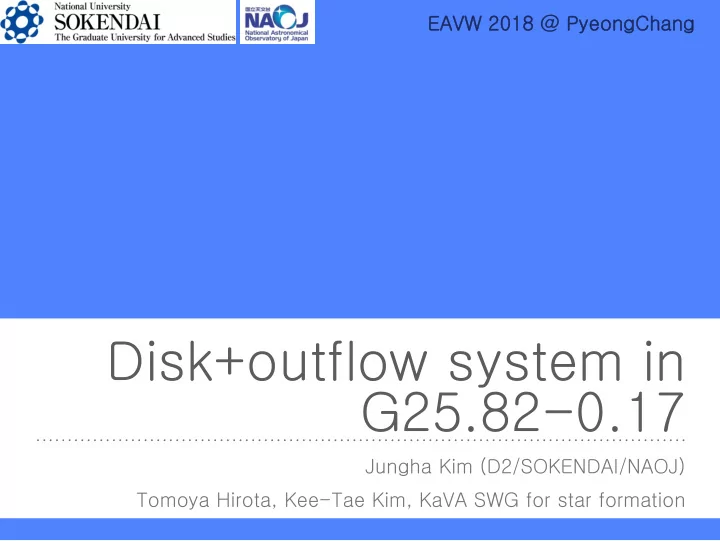

EA EAVW 2018 18 @ P Pyeo eongChang gChang Disk+outflow system in G25.82-0.17 Jungha Kim (D2/SOKENDAI/NAOJ) Tomoya Hirota, Kee-Tae Kim, KaVA SWG for star formation
CONTENTS ➤ Introduction ➤ Observations ➤ Results - KaVA imaging survey at 22 GHz - Case study toward G25.82-0.17 ➤ Future works
INTRODUCTION
HIGH-MASS STAR FORMATION (HMSF) Fe Feedback ack!! !!
HIGH-MASS STAR FORMATION (HMSF) HMSF is still far from understanding “ OBSERVATIONALLY ” ➤ Locations are distant ( > 1 kpc) ➤ Typically occurred in clustered environments. ➤ Evolutional time scale is ( ≲ 10 5 yrs). short Targets are rare and D=1 D=1.95 5 kpc (Xu Xu+2 +2006) 06) limited. LU LUCI I JH JHK s color composit ite image of f W3 Main (B (Bik ik+2012)
HIGH-MASS STAR FORMATION (HMSF) Evolutionary Sequence of high-mass young stellar objects (HMYSOs) Beltrán 2011 Observational studies to understand HMSF have been done.
DISK-OUTFLOW SYSTEM IN HIGH-MASS STAR FORMATION ➤ High velocity jets/outflows can be traced by resolving 1AU scale water maser structure to trace motion in milli arc second (mas)/month ➤ Large scale of view (disk+outflow) can be investigated by thermal The inner most part of jet/outflow line and continuum emission Beltran+2006 G24.78+0.08 Massive disks and outflow Disk in ~10 3-4 AU scale
MOTIVATIONS ➤ To establish an evolutionary scenario using different maser species enlarge samples of HMYSOs having VLBI image ➤ To investigate dynamics of jet/outflow+disk systems driven by HMYSOs by analyzing 3D velocity field and spatial structure of water masers ➤ To reveal their launching and mass accretion processes
OBSERVATIONS
KaVA (KVN and VERA Array) Base line range: 200 km ~ 2300 km Observable bands: 22 GHz and 44 GHz The highest angular resolution: ~1.2 mas @ 22 GHz
OBSERVATIONS KVN single dish survey based target list Methanol interesting sources KaVA LP 87 sources ALMA 12 sources VERA 2 sources G25.82-0.17 KaVA LP 1st 25 sources KaVA LP 2nd Sources having no VLBI 14 +2 sources image but also famous VLBI sources 14 sources including to verify our observations G25.82-0.17
RESULTS IMAGING SURVEY
SPECTRA OF WATER MASERS - EXAMPLES Systemic velocities Blue Red AFGL5142 Blue and Red S255N ~10 km s -1 ~200 km s -1 Blue only Lar arge ge veloc ocity ty distri ribut bution on Red only G351.243+0.671 G30.82-0.05 G28.37+0.07MM1 v~3 km s -1 ~40 km s -1
DISTRIBUTIONS OF WATER MASERS ➤ Two large trends in distributions of water masers 860 AU El Elongat ated ed 1,220 AU Compac Compact Each (0,0) is indicating position of the strongest water maser components
DISTRIBUTIONS OF WATER MASERS - EXAMPLES 1,660 AU 980 AU 356 AU 1,200 AU 428 AU 600 AU
RESULTS CASE STUDY
CASE STUDY - G25.82-0.17 ➤ G25.82-0.17 is one of high-mass star forming region. ➤ Detailed study toward this source has not been done yet. D~5.0 kpc Green & McClure-Griffiths 2011 1,000 AU ↑ Spatial distribution of water ↑ Water maser spectrum at 22 GHz masers. (green: systemic velocity of obtained with KaVA. 91 km s -1 ; shirley+2013)
CASE STUDY - G25.82-0.17 ➤ G25.82-0.17 is one of high-mass star forming region. 100 1,000 ➤ A compact distribution (within 0.15 x 0.15 arcsec) is shown with blue- and red shifted components. (first VLBI image)
G25.82-0.17 - DISTRIBUTIONS ➤ Detected molecular line emissions show a compact shell- like structure with velocity gradient within the shell. Rotating disk 𝑁 𝑒𝑣𝑡𝑢+𝑏𝑡 = 97 𝑁 ⨀ Channel maps of CH 3 OH 22 4 -21 5 E 5,000 AU +dust continuum peak The moment 1 map of CH 3 OH 22 4 -21 5 E (color) with the dust continuum emission (contours).
G25.82-0.17 - OUTFLOWS/SiO ➤ Complicated distribution of outflowing gas ➤ Similar distribution is shown in 229 GHz Class I methanol maser map (not shown) + water maser Blue: ≤ 90.2 km s -1 10,000 AU Red: ≥ 98.4 km s -1 Integrated intensity map of SiO 5-4 overlaid onto dust continuum emission
● - water masers G25.82-0.17 - OUTFLOWS * - class I methanol masers at 229 GHz + water maser 1,000 AU Another YSO? HM-YSO 10,000 AU Integrated intensity map of SiO 5-4 Gray scale - dust continuum emission overlaid onto dust continuum Contours - SiO outflow emission Outflow axes are inconsistent each other (SiO vs water maser) Measuring proper motion by monitoring observations is
FUTURE PROSPECTIVES - KAVA LP ➤ Monitoring observations using KaVA - In total, four epochs of observations in 2-3 months period will be done to measure proper motions of water masers toward 16 sources including G25.82-0.17. - Two epochs of observations were already done. 3d velocity field will be investigated to define parameters of outflows such as inclination ➤ Monitoring observations using VERA - Positions of maser spots will be derived using phase referencing method
SUMMARY ➤ The first year project of water maser survey at 22 GHz using KaVA has been done. ➤ Both blue and red shifted components were apparently detected toward 16 sources among 21 detected sources. Monitoring observations toward 16 sources are in progress. ➤ Disk+outflow system is detected toward G25.82-0.17 by ALMA follow-up observations. Masses derived from molecular line and dust continuum suggest that G25.82-0.17 is potential a HM-YSO. Outflowing gas traced by SiO and Class I methanol maser presents complicated structure, suggesting multiple outflows. ➤ Analysis of monitoring observations with KaVA and VERA is in progress.
Recommend
More recommend